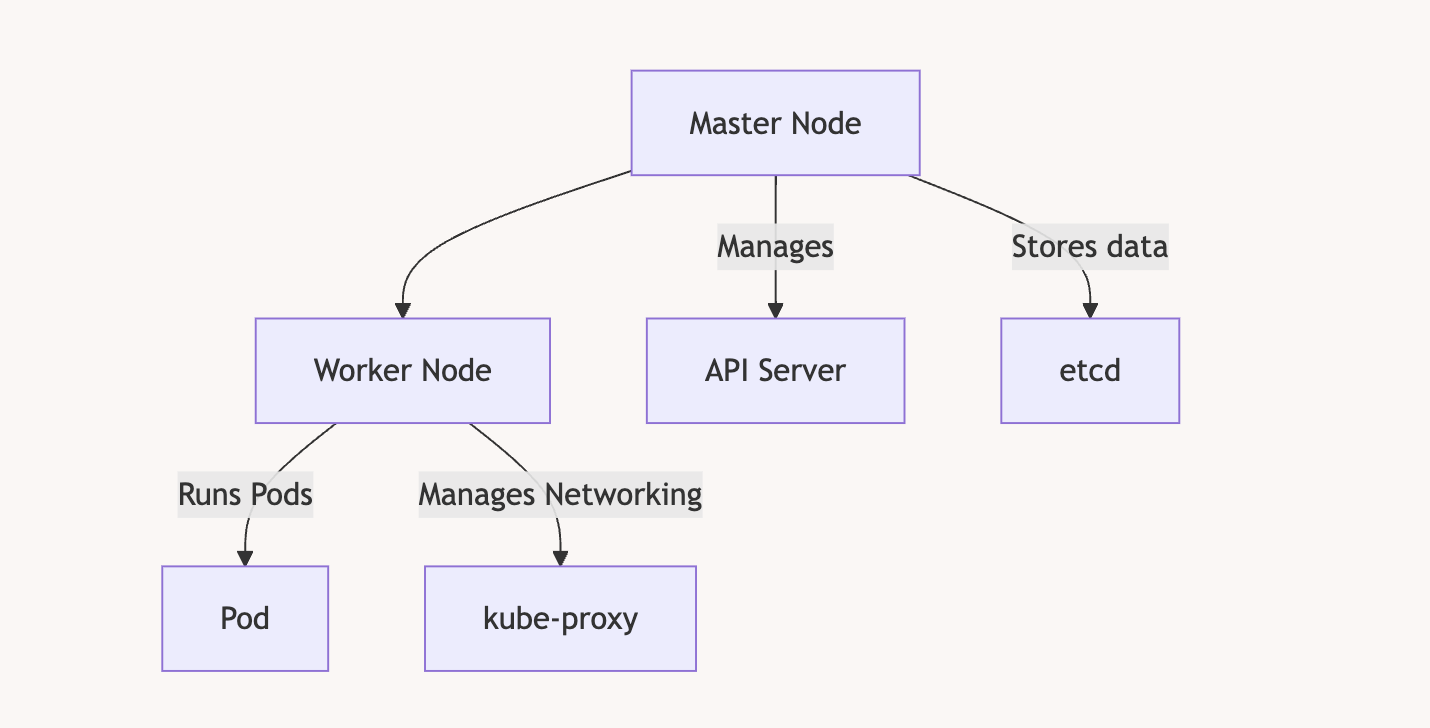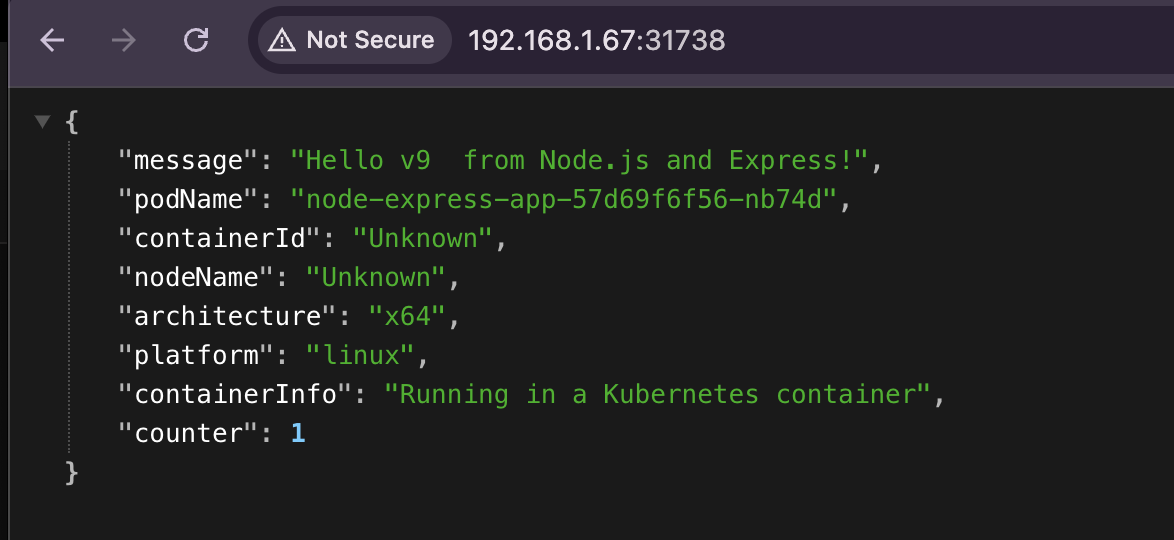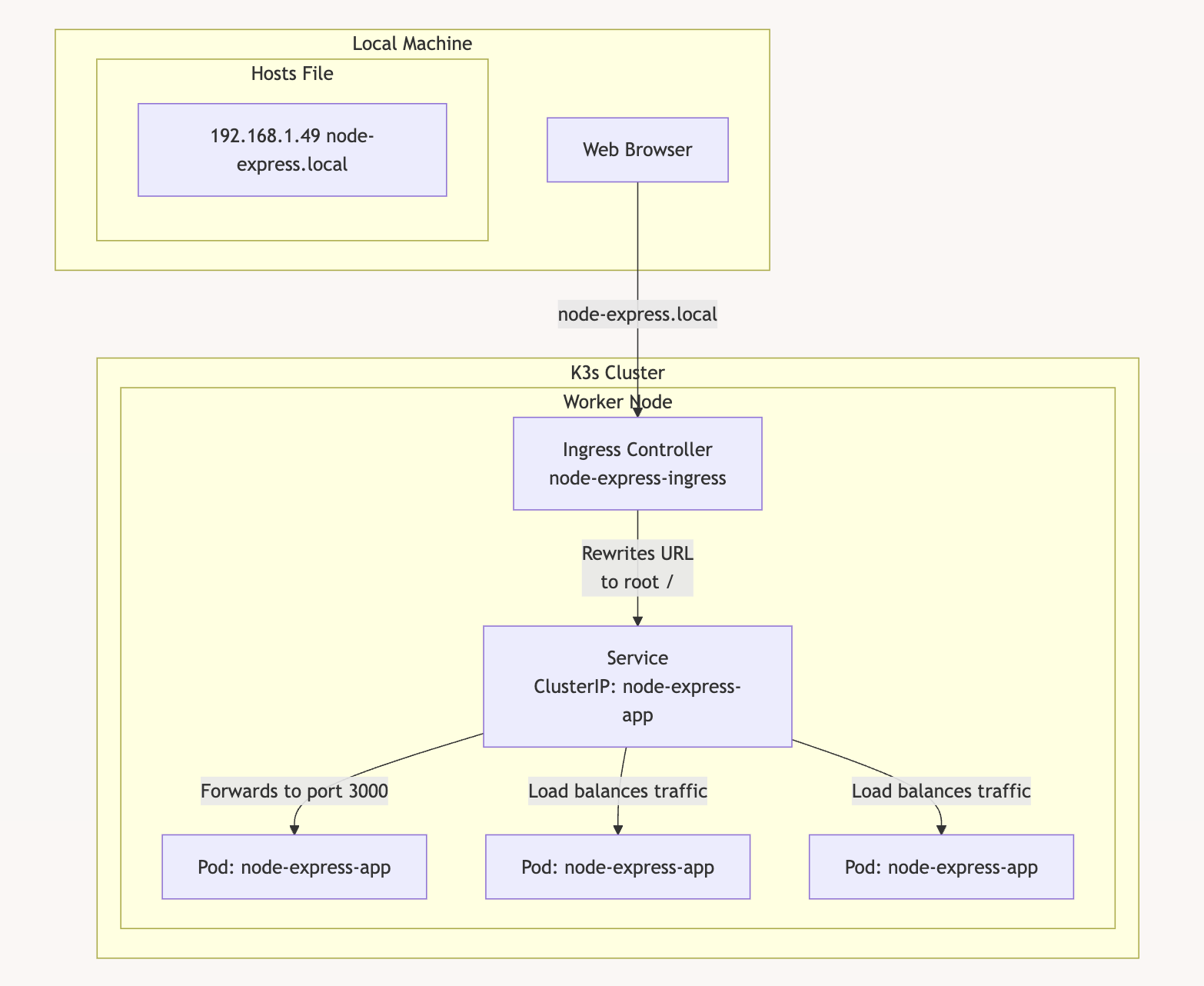17/12/2024
This article organizes step-by-step instructions for deploying, exposing, and managing Kubernetes workloads, handling connectivity issues, and ensuring self-healing deployments with K3s. These notes represent the of my personal experiments with K3s.
Install K3s
To install K3S, you need at least 2 VMs. In my case, I decided to use Debian VMs on Proxmox. The first VM will be the master node, and the second will be the worker node. The master node orchestrates the cluster and distributes the load across one or more worker nodes. As your application grows and requires more machines, you can simply add more worker nodes to the cluster.

Install the master node
curl -sfL https://get.k3s.io | sh -
Get the token
cat /var/lib/rancher/k3s/server/token
It will return something like
root@k8masterNode:~# cat /var/lib/rancher/k3s/server/token
K10ee9c18dac933cab0bdbd1c64ebece61a4fa7ad60fce2515a5fcfe19032edd707::server:64ee8a3fec9c3d1db6c2ab0fc40f8996
Get the IP of the machine
root@k8masterNode:~# ip addr show | grep 192
inet 192.168.1.67/24 brd 192.168.1.255 scope global dynamic ens18
Join the cluster from the worker node
NB : Be sure the worker node has a different hostname otherwise it will not work
If the VM has been cloned then run : sudo hostnamectl set-hostname <new-hostname>
curl -sfL https://get.k3s.io | K3S_URL=https://<server-ip>:6443 K3S_TOKEN=<token> sh -
curl -sfL https://get.k3s.io | K3S_URL=https://192.168.1.67:6443 K3S_TOKEN="K10ee9c18dac933cab0bdbd1c64ebece61a4fa7ad60fce2515a5fcfe19032edd707::server:64ee8a3fec9c3d1db6c2ab0fc40f8996" sh -
Creating and Exposing Deployments
Create a Deployment
kubectl create deployment nginx --image=nginx
Expose the Deployment
kubectl expose deployment nginx --type=NodePort --port=80
Verify the service:
kubectl get svc
Expected output:
NAME TYPE CLUSTER-IP PORT(S) AGE
nginx NodePort 10.43.212.89 80:30548/TCP 6s
Verify the pods:
kubectl get pods -o wide
Example:
NAME READY STATUS IP NODE
nginx-bf5d5cf98-knd5t 1/1 Running 10.42.1.3 workernode
Access the Nginx App:
curl http://<CLUSTER-IP>
curl http://<MASTER-IP>:<NODEPORT>
Example:
curl http://192.168.1.49
Or with the port like so (we deployed on port 80)
curl http://192.168.1.49:80
Managing a Deployment
Remove a Deployment
Delete the service:
kubectl delete service nginx
Delete the deployment :
kubectl delete deployment nginx
Confirm deletion:
kubectl get deployments
kubectl get svc
Building and Pushing Custom Docker Images
Build the Docker Image
Ensure your app is ready for deployment:
docker build -t node-express-app .
Login to DockerHub
docker login
Tag and Push the Image
docker tag node-express-app antoinebr/node-express-app:v1
docker push antoinebr/node-express-app:v1
Deploying Custom Applications
Create a Deployment YAML
Save as node-express-deployment.yaml:
apiVersion: apps/v1
kind: Deployment
metadata:
name: node-express-app
spec:
replicas: 6
selector:
matchLabels:
app: node-express-app
template:
metadata:
labels:
app: node-express-app
spec:
containers:
- name: node-express-app
image: antoinebr/node-express-app:v1
ports:
- containerPort: 3000
Apply the Deployment
kubectl apply -f node-express-deployment.yaml
Expose the Deployment
kubectl expose deployment node-express-app --port=80 --target-port=3000 --type=NodePort
Get App IP
kubectl get svc node-express-app
You will get something like :
root@k8masterNode:~# kubectl get svc node-express-app
NAME TYPE CLUSTER-IP EXTERNAL-IP PORT(S) AGE
node-express-app NodePort 10.43.239.152 <none> 80:31738/TCP 3m33s
Access the App:
curl http://<MASTER-IP>:<NODEPORT>
In my case :
curl http://192.168.1.67:31738

NB: To remove that deployement kubectl delete deployment node-express-app
Using an Ingress Controller
Deployment and Service Configurations
Create deployment.yaml:
apiVersion: apps/v1
kind: Deployment
metadata:
name: node-express-app
spec:
replicas: 3
selector:
matchLabels:
app: node-express-app
template:
metadata:
labels:
app: node-express-app
spec:
containers:
- name: node-express-app
image: antoinebr/node-express-app:v1
ports:
- containerPort: 3000
Create service.yaml:
apiVersion: v1
kind: Service
metadata:
name: node-express-app
spec:
selector:
app: node-express-app
ports:
- protocol: TCP
port: 80
targetPort: 3000
type: ClusterIP
Create ingress.yaml:
apiVersion: networking.k8s.io/v1
kind: Ingress
metadata:
name: node-express-ingress
annotations:
nginx.ingress.kubernetes.io/rewrite-target: /
spec:
rules:
- host: node-express.local
http:
paths:
- path: /
pathType: Prefix
backend:
service:
name: node-express-app
port:
number: 80
Apply Configurations
kubectl apply -f deployment.yaml
kubectl apply -f service.yaml
kubectl apply -f ingress.yaml
Set Hostname in Local System
Add to /etc/hosts:
192.168.1.49 node-express.local
Here’s a diagram of the setup

Handling Worker Node Connectivity Issues
Verify Node Status
kubectl get nodes
If workernode shows NotReady, check connectivity:
curl -k https://<MASTER-IP>:6443
Expected output:
{
"status": "Failure",
"message": "Unauthorized",
"reason": "Unauthorized",
"code": 401
}
Troubleshoot Worker Token
Verify the token:
cat /var/lib/rancher/k3s/server/token
Re-set the token:
echo "THE_TOKEN" | tee /var/lib/rancher/k3s/agent/token
Restart K3s Agent
sudo systemctl daemon-reload
sudo systemctl restart k3s-agent.service
Check Nodes
kubectl get nodes
Restarting K3s Service
Common Errors
- Port 6444 already in use:
sudo lsof -i :6444 kill -9 <PID> - Invalid server token:
Ensure the correct token is in:
/var/lib/rancher/k3s/server/token
Restart K3s
sudo systemctl restart k3s
Kubernetes Crash Handling
Kubernetes automatically restarts failed pods.
Check Pod Status:
kubectl get pods
Example output:
NAME READY STATUS RESTARTS AGE
node-express-app-8477686cf7-6fmvz 1/1 Running 0 30m
If a pod crashes, Kubernetes will reschedule it to maintain the desired replica count.
